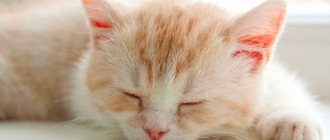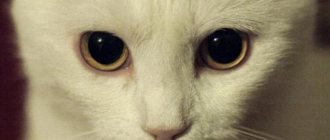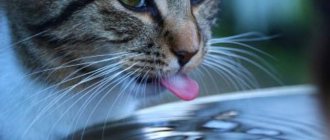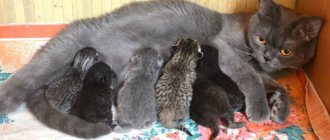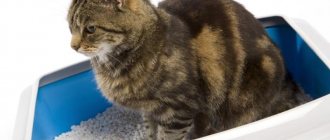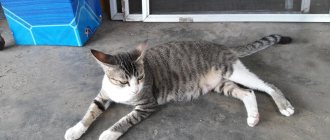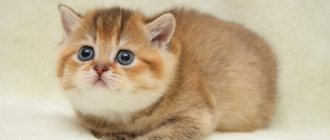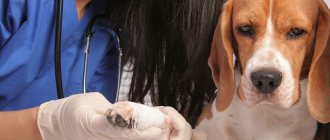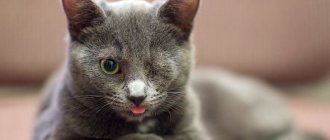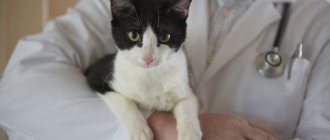Shortness of breath in a cat is more often caused physiologically, and less often occurs due to health problems. It is important for the owner to be able to distinguish the first from the second in order, if necessary, to promptly seek help from a veterinarian. Persistent and progressive respiratory failure can lead to the death of the pet.
Shortness of breath in a cat
Signs of a breathing disorder
You can guess that a cat has health problems if, while breathing:
- wheezing or whistling is heard;
- air is captured and released with difficulty;
- the animal sits in an unusual position, is worried, tries to lie down, but is suffocating, so it gets up again and again;
- the animal breathes with its mouth slightly open and it is clear that the mucous membranes of the gums and lips are pale pink or bluish in color;
- the frequency of inhalations and exhalations is noticeably higher or lower than normal.
Breathing with your mouth slightly open is a sure sign of shortness of breath
On a note! The body of animals living on land is designed in such a way that it does not accumulate precious oxygen, but receives it in the current mode from the air, through respiratory movements. If the process is disrupted for some reason, the animal’s life is endangered.
Reasons to urgently consult a doctor
A cat's breathing itself is often not always a cause for panic. As noted above, the animal could get scared, angry, tired during outdoor games, etc.
Various chronic or infectious diseases that the owner knows about can cause such a symptom, then the cat is simply treated with methods previously prescribed by the doctor. However, there are accompanying signs when you need to take your pet to the clinic urgently :
- rapid or too weak pulse;
- change in color of mucous membranes (red, blue, white shades);
- severe wheezing or gurgling in the chest;
- copious amounts of fluid coming from the mouth or nasal passages.
Also, you should not hesitate if the indicated symptoms are absent, but the owner does not even imagine why his cat may often breathe from his stomach. The sooner a doctor makes a diagnosis, the higher the chances of a favorable outcome.
Types of shortness of breath
Breathing difficulties in cats caused by diseases are classified into:
- bradypnea - rare breathing that occurs due to insufficient functioning of the corresponding center of the brain;
- tachypnea - frequent, shallow breathing - one of the signs of fever, and possibly blood pathologies.
Depending on the phase that is affected, shortness of breath is defined as:
- inspiratory, when breathing is difficult;
- expiratory, if there are problems with exhalation;
- mixed, when both phases suffer.
Normal respiratory rate per minute in cats
How to provide first aid?
If there is reason to suspect that the cat has choked and is therefore breathing frequently, you need to spread its jaws as wide as possible and, holding its mouth open, try to pull out the foreign body with your fingers or tweezers. It happens that such actions are unsuccessful due to too deep penetration of a foreign object into the larynx.
In such cases, the cat is lifted by the hind legs and held upside down. At the same time, they compress the stomach, pressing on the diaphragm with sharp thrusts. Most likely, the foreign body will pop out and the pet will be able to breathe normally.
A cat also needs emergency help if the change in breathing is associated with a heart attack, which can be determined by the accompanying symptoms.:
- cyanosis of the mucous membrane;
- pale skin;
- rapid or, conversely, slow pulse.
You should act as quickly as possible, without waiting for a critical condition. When the animal’s diagnosis is already known, it is injected with the drug prescribed by the doctor and taken out into the fresh air. If the condition is so serious that the pet has stopped breathing, you need to take basic resuscitation measures :
- lay the cat on a flat surface, fixing its body so that the spine from neck to tail is straightened;
- clear your mouth of mucus;
- hold the mouth with one hand and roll the other into a tube, through which you breathe directly into the pet’s nose approximately once every two to three seconds (in the case of kittens, the breathing rate is halved);
- perform an indirect cardiac massage if the pulse cannot be felt.
In most cases, after stopping breathing, a cat can be saved within 10-15 minutes. When the resuscitated animal begins to breathe normally, you should definitely take it to a veterinary clinic.
© shutterstock
Physiologically caused shortness of breath
It is characterized by the fact that:
- is caused by natural processes of the body’s vital functions and does not require treatment;
- essentially represents a reaction to the influence of stress factors or unfavorable conditions, after which the respiratory process in the animal returns to normal.
Causes
A physiological respiratory disorder develops in an animal when:
- Psycho-emotional stress. It is accompanied by the release of a large amount of adrenaline into the blood, which stimulates the heart. The body's need for oxygen increases sharply. To compensate for its deficiency, the cat begins to breathe more often and deeper.
A cat's breathing may be impaired due to psycho-emotional stress.
- Physical stress . When an animal runs a lot and quickly, the heart contracts more often, oxygen is consumed faster, so the cat breathes more actively than at rest. The same thing happens if the animal overheats.
- Stress due to chest injury. The injured pet, in addition to being frightened, experiences pain, which, if the ribs are broken, intensifies with breathing. Inhalations and exhalations become careful, superficial, and the animal’s mouth is open. The situation is critical and requires emergency measures.
Shortness of breath may occur due to chest trauma
Symptoms
We are talking about the behavior of a cat when shortness of breath can be explained by physiological reasons:
- the animal is worried about thirst and drinks a lot after active games and running;
- the pet becomes lethargic, looks for shade to hide and rest, and if it finds a wet surface, it lies down on it. This happens after a long stay in the heat. After a couple of hours, the cat comes to his senses, eats with pleasure and continues to lead an active lifestyle;
- the animal is restless and shows obvious signs of fright, one of which is dilated pupils. Perhaps you had to run away from the dog.
A cat's lethargic state indicates problems with the cat's health.
Attention! Such manifestations are considered a physiological norm when they are caused by appropriate circumstances.
How to help a cat
She needs to be left alone, offered a bowl of fresh, cool water, and then given the opportunity to rest and sleep.
Alarming symptoms
After giving birth, a cat often breathes with its mouth open
If a cat begins to breathe heavily from its stomach, this means that a sufficient amount of oxygen does not reach the lungs, which is why the body is in a stressful situation. There are many reasons for this phenomenon, but an accurate diagnosis can be made only after other accompanying symptoms have been studied.
Infections
Among the infectious and inflammatory diseases of the respiratory system in cats, the most common are:
- rhinitis;
- bronchitis;
- tracheitis;
- ORZ.
In this case, the animal’s body tries to fight the infection and the immune system is activated. As a result, mucus begins to be released abundantly, which contains a large number of leukocytes. This phenomenon can be considered normal, but clogged airways prevent the cat from breathing normally, which is why the pet breathes from its stomach.
A cat's cough is accompanied by nasal discharge and fever
If an animal gets sick, it can often be seen with its mouth open. Then the cat begins to cough, nasal discharge appears, and an unpleasant aroma comes from the mouth. Against the background of such symptoms, constant high body temperature should also be noted.
Often, infections can manifest themselves differently: the cat has bad bowel movements, vomiting, and ulcers appear in the mouth. Illnesses of the respiratory system can cause the animal to wheeze, whistle and sneeze.
Pneumonia
Pneumonia can often be confused with a common cold, but there are certain symptoms that will prevent you from being mistaken. Pneumonia is characterized by the following symptoms:
- general weakness: the cat may simply refuse to play with the owner, lie in his favorite place and sleep most of the time;
- increased thirst against the background of decreased appetite;
- dry nose along with clear or yellowish discharge;
- elevated temperature;
- increased secretion of the lacrimal and salivary glands.
When a cat first gets sick, he begins to develop noises and wheezing in his breathing. Pneumonia then begins to be characterized by a dry cough, which will turn into a wet cough as the disease progresses. If you suspect that your pet is developing this particular disease, it is worth checking the color of the mucous membranes: with pneumonia they become bluish in color. Also, the animal’s fur becomes less well-groomed, it lies unevenly and does not shine.
X-ray of a cat with pneumonia
Poisoning
When the question arises as to why your pet has difficulty breathing, you should think about poisoning. If a cat accidentally eats alkali or acid, his saliva secretion will increase, convulsions, pulse irregularities, trembling, diarrhea and vomiting will appear.
Oncology
It is not uncommon for an animal to develop cancer of the lungs or larynx. New growths in the animal's larynx interfere with the flow of air, causing the cat to experience discomfort.
In this case, you may notice symptoms such as cough, heavy breathing with an open mouth, hoarseness, and frequent secretion of saliva. The cough can be either dry or with discharge of blood and pus. As the disease progresses, the pet's voice changes. As a result of cancer, the cat begins to lose weight and develops a fever.
Note! If this condition lasts for a long period of time in a cat, it greatly affects the overall health of the animal. Most often, one can expect the development of chronic hypoxia. Additional diseases appear as the body weakens due to lack of oxygen.
Helminths
When infected with parasitic worms, cats lose their former activity, become lethargic, and spend most of their time lying down, gasping for air. Gradually, food refusal occurs, a dry cough and shortness of breath appear at the slightest physical exertion.
Pulmonary edema
Pulmonary edema is a condition in which fluid accumulates in the lungs and alveoli. This cannot be considered an independent disease, since swelling is only a symptom of other pathologies. Along with it, the cat may suffer from:
- cough;
- wheezing, whistling;
- rapid breathing;
- vomiting;
- foam from the nose and mouth;
- decreased activity;
- pallor and bluish tint on the mucous membranes.
If a combination of several signs of pathology is noticed, it is recommended to contact a veterinary clinic so that the animal can receive qualified assistance.
X-ray of a cat with pulmonary edema
Pneumothorax and hydrothorax
These diseases are the most dangerous for a pet. These pathologies appear as a result of injury. There are closed, open and valve pneumothorax. The latter poses the greatest danger to the animal, since air can enter the body, but does not leave it.
Important! Pneumothorax is characterized by the presence of a vacuum around the lungs, while hydrothorax is characterized by fluid. These pathologies do not appear as an independent disease. They develop against the background of heart failure, anemia, kidney and liver diseases.
X-ray of a cat with pneumothorax
In the presence of these diseases, stagnation of lymph in the veins occurs, the functionality of the heart muscle decreases, which can subsequently result in death. It is necessary to urgently consult a doctor, since the disease can progress within a month.
Serious injury greatly reduces the vitality of a pet, as infections can enter the body through the wound. Also, due to the influx of large amounts of air into the chest, the organs cool, which leads to a decrease in the size of the lungs.
Obesity is also not the norm for felines. If your cat too often tends to stick out his tongue and begin to inhale air frantically after minimal physical activity, you should think about his weight. Often such pets look like a ball with legs.
Obese cat
In case of heart failure, the animal develops shortness of breath, the cat begins to cough, and breathes heavily with its stomach. In most cases, you can notice how your pet's mucous membranes turn pale and acquire a bluish tint. Foam starts coming out of the mouth and nose less often. Such symptoms appear immediately after physical activity and disappear after some time.
Prevention recommendations
Considering that there can be many causes of respiratory disorders in cats, prevention comes down to maintaining the normal health of the pet. When it is at the proper level, the animal is hardy and gets sick less often. In this regard, it is recommended:
- Feed the cat regularly and in a balanced manner so that it receives the required amount of proteins, vitamins and minerals. The optimal diet will be premium and super premium ready-made food;
- make sure that in the summer the animal has somewhere to hide from the heat and heat, and also drink plenty of fresh water;
- do not overfeed your pet and do not force it to run or play after eating;
- Monitor your cat's health.
How to feed a cat
Attention! If he begins to breathe heavily, you should not expect that “everything will go away on its own.” If you suspect a pathology, you should show the animal to a veterinarian, and then follow all his recommendations with precision.
How can I help at home?
The cat needs to be kept calm and not create additional stress on the respiratory system (it is vitally important not to agitate the cat, this can be very dangerous!). Under no circumstances should you try to put the cat down or give it water - this can be dangerous.
There is no need to use any drugs that stimulate breathing - in most cases this is not only pointless, but can also be harmful. It is necessary to take the animal to the doctor as quickly and carefully as possible.
Respiratory diseases of cats - diagnosis and treatment
For chronic diseases of the upper respiratory tract, the examination includes x-rays of the skull. Also, if possible, a computed tomography scan of the skull. All this is done in combination with a thorough examination of the oral cavity, rhinoscopy and laryngoscopy.
Cats with suspected pleural effusion undergo chest x-ray and ultrasound with possible thoracentesis. Assessment of pleural fluid is used to differentiate types of effusions.
For pathologies of the lower respiratory tract, a good quality radiograph of the chest cavity is important. Lateral and ventrodorsal (or dorsoventral) views should be made. X-rays can confirm and localize the disease and provide information about the severity of changes.
Cytological examination of respiratory tract swabs is used to assess mucus and characterize the type of inflammatory process.
Depending on the results of the examination, specific therapy may be used for treatment. This may be antimicrobial, antiparasitic, antifungal or antitumor therapy.
Treatment of asthma in cats
As with humans with asthma, feline respiratory illnesses respond to a combination of bronchodilators and corticosteroids (in oral or injectable forms). Cats with chronic bronchitis or chronic obstructive pulmonary disease may also respond to long-term combination therapy with corticosteroids and bronchodilators. Many nonspecific therapies may also be helpful. For example, drip infusions, anti-inflammatory drugs.
In many cats, respiratory syndromes are untreatable and can eventually lead to heart or lung failure.
Follow-up studies and patient monitoring are necessary to refine drug dosing and effectively control chronic respiratory disease in cats.
For prevention, it is recommended to comply with vaccination schedules and limit exposure to infectious agents. Measures are needed to minimize exposure to irritating substances - dust, cigarette smoke, harmful fumes. It is also necessary to get rid of allergens and mold in order to prevent respiratory diseases.
Oncology
Among the causes, tumors should be specifically noted. They can be benign or cancerous, with metastases or not. Oncology often affects adult animals and is much less common than in dogs. A tumor can develop against the background of any disease, including respiratory diseases.
New growths of any form grow, exerting strong pressure. Wheezing occurs when the tumor has invaded any part of the respiratory tract. The tumor makes breathing significantly more difficult. If the tumor appears in or near the throat, the cat swallows heavily and wheezes when it breathes. At the same time, hoarseness of voice, squeaking, shortness of breath and coughing up blood appear.
In any case, when a cat is breathing heavily and this is accompanied by wheezing, the animal must be shown to a veterinarian. Basically, these are symptoms of a disease. A lack of air is also indicated when a cat sleeps with its mouth open. If animals have respiratory diseases, there should always be a bowl of clean water.
The cat remains a beloved pet, despite the chaos in the apartment, heart-rending screams or harmful character. Most furry beauties are sociable creatures, trying to express their thoughts and feelings to their owner, purring, meowing, and in some cases screaming heart-rendingly. Therefore, unexpected silence, hissing or wheezing in a cat immediately alerts a caring owner. What may cause such changes is described in this article.
